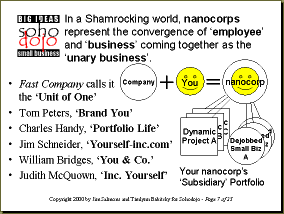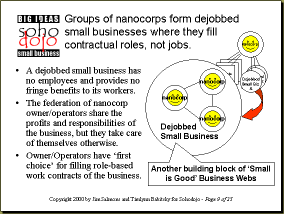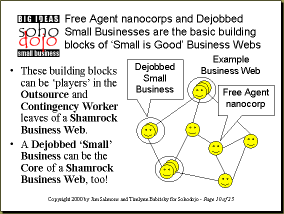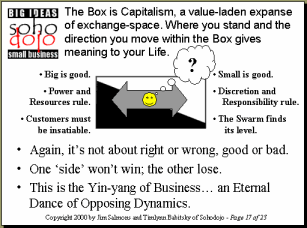
The Entrepreneurial Free Agent and Dejobbed Small Business R&D Lab
Sohodojo, 'War College' for the Small Is Good
The Nanocorp,
Organizing Principles and Scale in
Related pages:
Overview: This two-part article describes the BIG IDEAS for small business being explored at Sohodojo. In part one of this article, we use an analogy to atomic theory and the composition of molecules to describe the network structure underlying Small Is Good Business Webs. In part two, we use a scenario-based case study to examine how the Network Effect can be harnessed by Small Is Good Business Webs, not only to compete with conventional businesses, but to open new markets based on the unique strengths of Small Is Good Business Webs.
The Nanocorp and Atomic Theory
Can Small Is Good Business Webs composed of collaborating nanocorps (entreprenurial individuals and 'working families') really produce the scale of success that conventional businesses achieve? Can self-managing, distributed bands of entrepreneurial collaborators (what Ishmael's Daniel Quinn calls New Tribal Ventures) truly compete in the ruthless and fast-paced markets of today's global economy?
 Most of us hold the unquestioned belief that significant success is only achieved through scale and growth. "Start small, grow large; if you don't do that, you will not succeed. It's an economic Law of Success! Everyone knows this is true, how can we question it?"
Most of us hold the unquestioned belief that significant success is only achieved through scale and growth. "Start small, grow large; if you don't do that, you will not succeed. It's an economic Law of Success! Everyone knows this is true, how can we question it?"
As entrepreneurs in this new millennium, supported by incredible empowering technology, we must face the subtle fears and apprehensions that our cultural beliefs provide us. We must suspend disbelief that some other possibility exists. We must avoid what Thomas Kuhn would consider the blindspot of Normal Science at the dawn of a paradigm-shifting scientific revolution. For us, the science is the soft science of business, and the revolution is the Small Is Good Business Revolution we are exploring here at Sohodojo.
 Apprehension, about the potential of something as small as a nanocorp self-organizing into a collaborative network that can emerge as a significant and market-shaping business "life form," is not new. The ancient Greeks wrestled with understanding the new and counter-intuitive atomic theory of Democritus. "How could such a theory be true? Can the elephant and the whale really be composed of such uniformly tiny bits, these so-called atoms? Could such uniformity of constituent parts account for the diversity of the gazelle and the sloth, the human and the mollusk?"
Apprehension, about the potential of something as small as a nanocorp self-organizing into a collaborative network that can emerge as a significant and market-shaping business "life form," is not new. The ancient Greeks wrestled with understanding the new and counter-intuitive atomic theory of Democritus. "How could such a theory be true? Can the elephant and the whale really be composed of such uniformly tiny bits, these so-called atoms? Could such uniformity of constituent parts account for the diversity of the gazelle and the sloth, the human and the mollusk?"
The answer, then as now, lies in composition driven by organizing principles powered by the network effect.
 Yes, nanocorps are small. They are so tiny in fact, that they are the unary business, the elementary particle, the atom of our new network-based organizational forms. Atom-like nanocorps can operate alone, offering a myriad of services to any number of others, and they can form molecule-like compositions we call dejobbed small businesses. A dejobbed small business is a collection of nanocorps working together under a 'corporate' wrapper.
Yes, nanocorps are small. They are so tiny in fact, that they are the unary business, the elementary particle, the atom of our new network-based organizational forms. Atom-like nanocorps can operate alone, offering a myriad of services to any number of others, and they can form molecule-like compositions we call dejobbed small businesses. A dejobbed small business is a collection of nanocorps working together under a 'corporate' wrapper.
For example, the dejobbed small business Just-In-Time Publishing Inc. may include Jones Inc., (nanocorp) for sales and marketing, JJSmith Inc., (nanocorp) for copy editing and indexing, Suliman LLC., (the Sulliman family nanocorp) for layout and graphics, Marcus Inc., (nanocorp) for printing and binding, and Fastman LLC, (nanocorp) for shipping and distribution. Just-In-Time has no employees. Instead, there are peer collaborators (nanocorps) who perform particular business roles.
 Dejobbed small businesses provide the opportunity for nanocorps to aggregate for branding and income distribution, and to develop business opportunities that any one of them alone might not secure. Aggregation, enabled by mentor-based replication and peer-to-peer cooperation, is the nanocorp's alternative to the monolithic growth of the conventional corporation.
Dejobbed small businesses provide the opportunity for nanocorps to aggregate for branding and income distribution, and to develop business opportunities that any one of them alone might not secure. Aggregation, enabled by mentor-based replication and peer-to-peer cooperation, is the nanocorp's alternative to the monolithic growth of the conventional corporation.
Extended networks of nanocorps and dejobbed small businesses can form Small Is Good Business Webs, an emerging new business life form that will compete with Industrial era corporations in the markets of the 21st Century. While conventional corporations seek operational efficiencies through growth and control, Small Is Good Business Webs will scale through aggregation and cooperation.
 We're not the only ones proclaiming the competitiveness of collaborative entrepreneurial networks. Researchers from MIT's Initiative for Inventing the Organizations of the 21st Century have written persuasively in the Scenarios Project report about the emergence of shifting networks of small firms. Principle investigators Robert Laubacher and Tom Malone see these collaborative networks as the 'new kids on the block' of business competition. The Scenarios Project findings are explored further in Malone and Laubacher's 1998 Harvard Business Review landmark article, The Dawn of the E-Lance Economy.
We're not the only ones proclaiming the competitiveness of collaborative entrepreneurial networks. Researchers from MIT's Initiative for Inventing the Organizations of the 21st Century have written persuasively in the Scenarios Project report about the emergence of shifting networks of small firms. Principle investigators Robert Laubacher and Tom Malone see these collaborative networks as the 'new kids on the block' of business competition. The Scenarios Project findings are explored further in Malone and Laubacher's 1998 Harvard Business Review landmark article, The Dawn of the E-Lance Economy.
Laubacher and Malone present a convincing argument, including cited cases, for the competitiveness of 'elastic networks' of small firms. However, like Tapscott, Ticol and Lowy in Digital Capital, Malone and Laubacher stay within the comfort zone of conventional business thinking. They implicitly accept the 'driver' of Big Is Good organizing principles. While relative advantage may accrue to nimble bands of freelance collaborators, there is an undercurrent of acknowledgment in Malone and Laubacher's work that large corporations and conventional markets shape the domain of business.
The Small Is Good Business Revolution seeks to shatter this conception to enable the envisioning of new business forms and qualitatively different marketplaces.
On Organizing Principles and Entrepreneurism
The Small Is Good Business Revolution has many facets. We've written elsewhere about models for new organizational forms that will contribute to this revolution. Organizational structure reflects the underlying organizing principles of a business. Over the lifecycle of a business, its organizing principles act like DNA, determining the potential structure and processes throughout the organization.
 Business organizing principles tend to fall within one of two clusters – Small Is Good or Big is Good. Big is Good organizing principles are based on the unquestioned Law of Success. But recent events investigating how Big Business operates and the explosion/implosion of the dot.com bubble are questioning the organizing principles on which the Law of Success is grounded. More than ever we must suspend disbelief that some other possibility exists.
Business organizing principles tend to fall within one of two clusters – Small Is Good or Big is Good. Big is Good organizing principles are based on the unquestioned Law of Success. But recent events investigating how Big Business operates and the explosion/implosion of the dot.com bubble are questioning the organizing principles on which the Law of Success is grounded. More than ever we must suspend disbelief that some other possibility exists.
Entrepreneurs everywhere carry the seeds to start and develop new businesses. The entrepreneur then is the essential carrier of a specific bundle of organizing principle 'genes' that shape the future business. We believe that the Small Is Good Business Revolution will emerge with a new class of entrepreneurs. We, Sohodojo-Jim and Sohodojo-Timlynn, are members of this new face of private enterprise. We, like all entrepreneurs, are highly competitive, intent on success, and strive for dominant market positions for our business ventures. We intend our businesses to change the world and transform marketplaces. In these and many other ways, we are indistinguishable from 'conventional' entrepreneurs.
But we are different in some fundamental ways:
We don't desire to get rich. Money is a means to an end, not an end in itself. We don't need piles of money to be happy.
What we do and with whom we do it are more important to us than how much money we make. Is it interesting? Will I learn something? Is someone I trust and admire also involved?
We don't ascribe to a 'store-and-forward' model of entrepreneurial social change. We don't believe in getting rich first, then engaging in philanthropic activities for social benefit. (Too many conventional entrepreneurs do the 'storing' part then fall short on the 'forwarding'.)
We ascribe to a 'pass-through' model of entrepreneurial social change. We intend for our entrepreneurial ventures to be tremendous wealth generators. However, our goal is to make enough money for as many people as possible. We don't want to make a small number of rich people richer.
We believe in 'human-scale' organizations and associated technologies. We are not interested in empire-building and the inherent complexity that such growth entails. History proves time and again that empires are not sustainable. (See Daniel Quinn's Beyond Civilization.)
We're not typical 'do-gooders' who reflexively shrink at words like capitalism, competition, and winning. We simply ascribe to values and goals that allow us to envision our businesses and how they operate in the world, differently.
In the second part of this article, we'll explore how the 'genes' of this new face of private enterprise can give birth to exciting new business models that are both competitive and humane. We'll see how the Network Effect can be harnessed to distribute wealth throughout a business web of entrepreneurial collaborators. This is a business model that we believe can contribute real value in addressing the social and economic problems characterized as the Digital Divide.
—Jim Salmons and Timlynn Babitsky—
23 January 2002
Revised 20 August 2002
Raleigh, NC USA
© 1998-2010 Sohodojo, Inc. | Our Privacy Statement
"War College" of the Small Is Good Business Revolution
Website design and hosting by Sohodojo Business Services,
A Portfolio Life nanocorp

[ Support Sohodojo ]
[ Translate page ]
[ Search site ]
![]() Complaint? Irritation? Suggestion?
Complaint? Irritation? Suggestion?
Tell us, please.